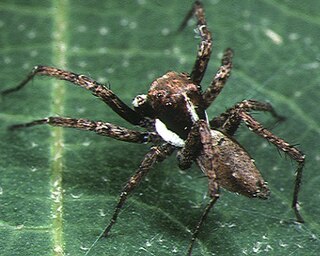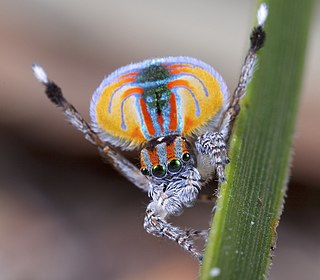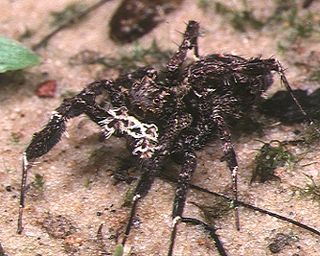
Jumping spiders or the Salticidae are a family of spiders. As of 2019, it contained over 600 described genera and over 6000 described species, making it the largest family of spiders at 13% of all species. Jumping spiders have some of the best vision among arthropods and use it in courtship, hunting, and navigation. Although they normally move unobtrusively and fairly slowly, most species are capable of very agile jumps, notably when hunting, but sometimes in response to sudden threats or crossing long gaps. Both their book lungs and tracheal system are well-developed, and they use both systems. Jumping spiders are generally recognized by their eye pattern. All jumping spiders have four pairs of eyes, with the anterior median pair being particularly large.

Portia is a genus of jumping spider that feeds on other spiders. They are remarkable for their intelligent hunting behaviour, which suggests that they are capable of learning and problem solving, traits normally attributed to much larger animals.

Portia labiata is a jumping spider found in Sri Lanka, India, southern China, Burma (Myanmar), Malaysia, Singapore, Java, Sumatra and the Philippines. In this medium-sized jumping spider, the front part is orange-brown and the back part is brownish. The conspicuous main eyes provide vision more acute than a cat's during the day and 10 times more acute than a dragonfly's, and this is essential in P. labiata′s navigation, hunting and mating.

Jotus is a spider genus of the family Salticidae, native to Australia, New Zealand, and Indonesia. There are thought to be many as yet undescribed species in southern Australia.

Maratus is a spider genus of the family Salticidae. These spiders are commonly referred to as peacock spiders due to the males' colorful and usually iridescent patterns on the upper surface of the abdomen often enhanced with lateral flaps or bristles, which they display during courtship. Females lack these bright colors, being cryptic in appearance. In at least one species, Maratus vespertilio, the expansion of the flaps also occurs during ritualised contests between males. The male display and courtship dance are complex, involving visual and vibratory signals.

Maratus volans is a species in the jumping spider family (Salticidae), belonging to the genus Maratus. These spiders are native to certain areas in Australia and occupy a wide distribution of habitats. They have a specialized visual system that allows them to see the full visible spectrum as well as in the UV-range; this helps them detect and pursue prey. Males of this species are characterized by their colorful abdomen flaps that are used to attract females during courtship.

Phidippus californicus is a species of jumping spider. It is found in the southwestern United States and northern Mexico.

Maevia inclemens is a relatively common and colorful jumping spider of North America. In the males there are two forms, a very rare phenomenon in zoology. These use different courting displays, and differ in appearance: the "tufted" morph has a black body and pedipalps ("palps"), three black tufts across its "head", and pale legs; and the "gray" morph has black and white stripes all over its body and legs, orange palps, and no tufts. However, each form accounts for 50% of the adult males, and they are equally successful in mating. A female of Maevia inclemens is 6.5 to 8.0 millimetres long, while males are 4.75 to 6.50 millimetres long.

Zygoballus sexpunctatus is a species of jumping spider which occurs in the southeastern United States where it can be found in a variety of grassy habitats. Adult spiders measure between 3 and 4.5 mm in length. The cephalothorax and abdomen are bronze to black in color, with reddish brown or yellowish legs. The male has distinctive enlarged chelicerae and front femora. Like many jumping spiders, Z. sexpunctatus males exhibit ritualized courtship and agonistic behavior.

Portia fimbriata, sometimes called the fringed jumping spider, is a jumping spider found in Australia and Southeast Asia. Adult females have bodies 6.8 to 10.5 millimetres long, while those of adult males are 5.2 to 6.5 millimetres long. Both sexes have a generally dark brown carapace, reddish brown chelicerae ("fangs"), a brown underside, dark brown palps with white hairs, and dark brown abdomens with white spots on the upper side. Both sexes have fine, faint markings and soft fringes of hair, and the legs are spindly and fringed. However, specimens from New Guinea and Indonesia have orange-brown carapaces and yellowish abdomens. In all species of the genus Portia, the abdomen distends when the spider is well fed or producing eggs.

Portia schultzi is a jumping spider which ranges from South Africa in the south to Kenya in the north, and also is found in West Africa and Madagascar. In this species, which is slightly smaller than some other species of the genus Portia, the bodies of females are 5 to 7 mm long, while those of males are 4 to 6 mm long. The carapaces of both sexes are orange-brown with dark brown mottling, and covered with dark brown and whitish hairs lying over the surface. Males have white tufts on their thoraces and a broad white band above the bases of the legs, and these features are less conspicuous in females. Both sexes have tufts of orange to dark orange above the eyes, which are fringed with pale orange hairs. Males' abdomens are yellow-orange to orange-brown with blackish mottling, and on the upper sides are black and light orange hairs, and nine white tufts. Those of females are pale yellow and have black markings with scattered white and orange-brown hairs on the upper side. P. schultzi has relatively longer legs than other Portia, and a "lolloping" gait.

Peckhamia is a peer-reviewed, open-access, scientific journal covering research on jumping spiders. It is published by the Peckham Society, an international organization of naturalists and scientists with an interest in jumping spiders, named in honor of George and Elizabeth Peckham. The journal was established in 1977 and its current editor-in-chief is David E. Hill.

Maratus speciosus, sometimes called the coastal peacock spider, is an Australian species of jumping spider. They are only known to inhabit the vegetation of the coastal sand dunes of southwestern Western Australia. Like other Maratus spiders, the males of the species engage in a courtship display during which they raise their third pair of legs and their abdomen, presenting their colorful opisthosomal plate to potential female partners. Unlike other Maratus, however, the males of this species have a set of bright orange hairs (setae) along both edges of the opisthosoma which only become visible during this display.
Maratus jactatus is a species of the genus Maratus, an Australian member of the jumping spider family. Maratus Jactatus have the ability to jump lengths up to 50 times their size of about 10mm. The female has a cryptically colored back, whereas the male has the colorful back. They have been collected only in Wondul Range National Park in southern Queensland. Like other Maratus spiders, the males of the species engage in a courtship display, during which they extend their median and posterior fringed spinnerets. They also spread the flaps from over their inflated opisthomal plate, revealing unique iridescent blue scales "interrupted by three bold transverse bands of red-orange to orange pigmented scales." A male presents both the extended spinnets and his expanded and inflated opisthoma as he faces the female that he courts. However, depending on the colors of the male, the female may be more likely to go to another male or not be attracted to certain males.
Maratus sceletus is a species of the genus Maratus, an Australian member of the jumping spider family. Described in 2015, they have been collected only in Wondul Range National Park in southern Queensland. The species name is derived from the Latin sceletus "skeleton", from its distinctive body pattern. Maratus sceletus is a small species, from 3.7 to 4.7 mm long. The male is black with prominent white stripes and markings across its carapace and legs.

Hyllus semicupreus, the heavy-bodied jumper, also known as the semi-coppered heavy jumper, is a species of spider of the genus Hyllus. It is native to India and Sri Lanka.
Maratus vespa is a species of the peacock spider genus, Maratus, characterised by its distinctive courtship display. The male spiders are characterized by a bright abdomen, lateral flaps, and an elongated third pair of legs. When attempting to attract a mate, the male spider will raise its colorful abdomen and elongated third pair of legs and wave them, along with extending its lateral flaps. This complex display of courtship is analogous of that of a peacock, hence the common name of this spider species.

Lyssomanes viridis, commonly known as the magnolia green jumper, is a species of jumping spider of the genus Lyssomanes, for which it is the type species. The species is native to the United States, being found in much of the Southeastern United States and Texas. It has also been reported from parts of Mexico, with sightings as far south as Guatemala and as far north as Delaware.

Maratus pavonis is a species of jumping spider (Salticidae), endemic to Australia, where it is found in Western Australia, New South Wales, Victoria and Tasmania. The species epithet, pavonis, derives from the Latin, pavo, pavonis, meaning "peacock".

Saitis mutans is a species of spider in the genus Saitis. It is endemic to Australia.















